Convective–Microwave–IR Hybrid Drying of Kaolin Clay—Kinetics of Process
Abstract
1. Introduction
2. Materials and Methods
2.1. Material
2.2. Drying Procedures
- convective—hot air;
- microwave;
- infrared.

- air temperature Ta = 85 °C;
- air flow velocity va = 1.2 m/s;
- microwave power PMW = 100 W (if used);
- infrared power PIR = 250 W (if used).
2.3. Determination of the Drying Constant
2.4. Formal Analysis
3. Results and Discussion
3.1. Kinetics of Process and Quality of Products
3.2. Energy Consumption
3.3. Calculation of the Drying Constant k
4. Conclusions
Author Contributions
Funding
Institutional Review Board Statement
Informed Consent Statement
Data Availability Statement
Conflicts of Interest
References
- Itaya, Y.; Mori, S.; Hasatani, M. Drying of Ceramics. In Handbook of Industrial Drying, 4th ed.; Mujumdar, A.S., Ed.; Taylor and Francis: Oxfordshire, UK, 2015; pp. 17–28. [Google Scholar]
- Ratti, C.; Mujumdar, A.S. Infrared Drying. In Handbook of Industrial Drying, 4th ed.; Mujumdar, A.S., Ed.; Taylor and Francis: Oxfordshire, UK, 2015; pp. 405–420. [Google Scholar]
- Habib, K.; Dilvin, T. Drying of Carrot Slices Using Infrared Radiation. Int. J. Food Sci. Technol. 2009, 44, 953–959. [Google Scholar] [CrossRef]
- Zare, D.; Naderi, H.; Ranjbaran, M. Energy and Quality Attributes of Combined Hot-Air/Infrared Drying of Paddy. Dry. Technol. 2015, 33, 570–582. [Google Scholar] [CrossRef]
- Doymaz, I. Infrared Drying of Sweet Potato (Ipomoea Batatas L.) Slices. J. Food Sci. Technol. 2012, 49, 760–766. [Google Scholar] [CrossRef]
- Guo, L.L.; Zhou, L.Y.; Bi, J.F.; Deng, F.M.; Yi, J.Y.; Chen, Q.Q. Optimization of Medium-and Short-Wave Infrared Radiation Drying Process for Shiitake Mushroom. Food Sci. 2016, 37, 44–51. [Google Scholar] [CrossRef]
- Schiffman, R.F. Microwave and Dielectric Drying. In Handbook of Industrial Drying, 4th ed.; Mujumdar, A.S., Ed.; Taylor and Francis: Oxfordshire, UK, 2015; pp. 283–301. [Google Scholar]
- Kowalski, S.J.; Banaszak, J.; Rybicki, A. Damage Analysis of Microwave-Dried Materials. AIChE J. 2012, 58, 2097–2104. [Google Scholar] [CrossRef]
- Kowalski, S.J.; Rajewska, K.; Rybicki, A. Mechanical effects in saturated capillary-porous materials during convective and microwave drying. Dry. Technol. 2004, 22, 2291–2308. [Google Scholar] [CrossRef]
- Itaya, Y.; Uchiyama, S.; Hatano, S.; Mori, S. Drying Enhancement of Clay Slab by Microwave Heating. Dry. Technol. 2005, 23, 1243–1255. [Google Scholar] [CrossRef]
- Vorhauer, N.; Tretau, A.; Bück, A.; Prat, M. Microwave drying of wet clay with intermittent heating. Dry. Technol. 2019, 37, 664–678. [Google Scholar] [CrossRef]
- Briest, L.; Wagner, R.; Tretau, A.; Tsotsas, E.; Vorhauer-Huget, N. Microwave-assisted drying of clay roof tiles. Dry. Technol. 2022, 40, 1804–1818. [Google Scholar] [CrossRef]
- Hammouda, I.; Mihoubi, D. Comparative numerical study of kaolin clay with three drying methods: Convective, convective–microwave and convective infrared modes. Energy Convers. Manag. 2014, 87, 832–839. [Google Scholar] [CrossRef]
- Łechtańska, J.M.; Szadzińska, J.; Kowalski, S.J. Microwave-and infrared-assisted convective drying of green pepper: Quality and energy considerations. Chem. Eng. Process. Process Intensif. 2015, 98, 155–164. [Google Scholar] [CrossRef]
- Saengrayap, R.; Tansakul, A.A.; Mittal, G.S. Effect of far-infrared radiation assisted microwave-vacuum drying on drying characteristics and quality of red chilli. J. Food Sci. Technol. 2015, 52, 2610–2621. [Google Scholar] [CrossRef]
- Aydogdu, A.; Sumnu, G.G.; Sahin, S. Effects of microwave-infrared combination drying on quality of eggplants. Food Bioprocess Technol. 2015, 8, 1198–1210. [Google Scholar] [CrossRef]
- Si, X.; Chen, Q.; Bi, J.J.; Yi, J.; Zhou, L.; Wu, X. Infrared radiation and microwave vacuum combined drying kinetics and quality of raspberry. J. Food Process Eng. 2016, 39, 377–390. [Google Scholar] [CrossRef]
- Chayjan, R.A.; Dibagar, N.; Alaei, B. Drying characteristics of zucchini slices under periodic infrared-microwave vacuum conditions. Heat Mass Transf. 2017, 53, 3473–3485. [Google Scholar] [CrossRef]
- Musielak, G.; Śliwa, T. Modeling and Numerical Simulation of Clays Cracking During Drying. Dry. Technol. 2015, 33, 1758–1767. [Google Scholar] [CrossRef]
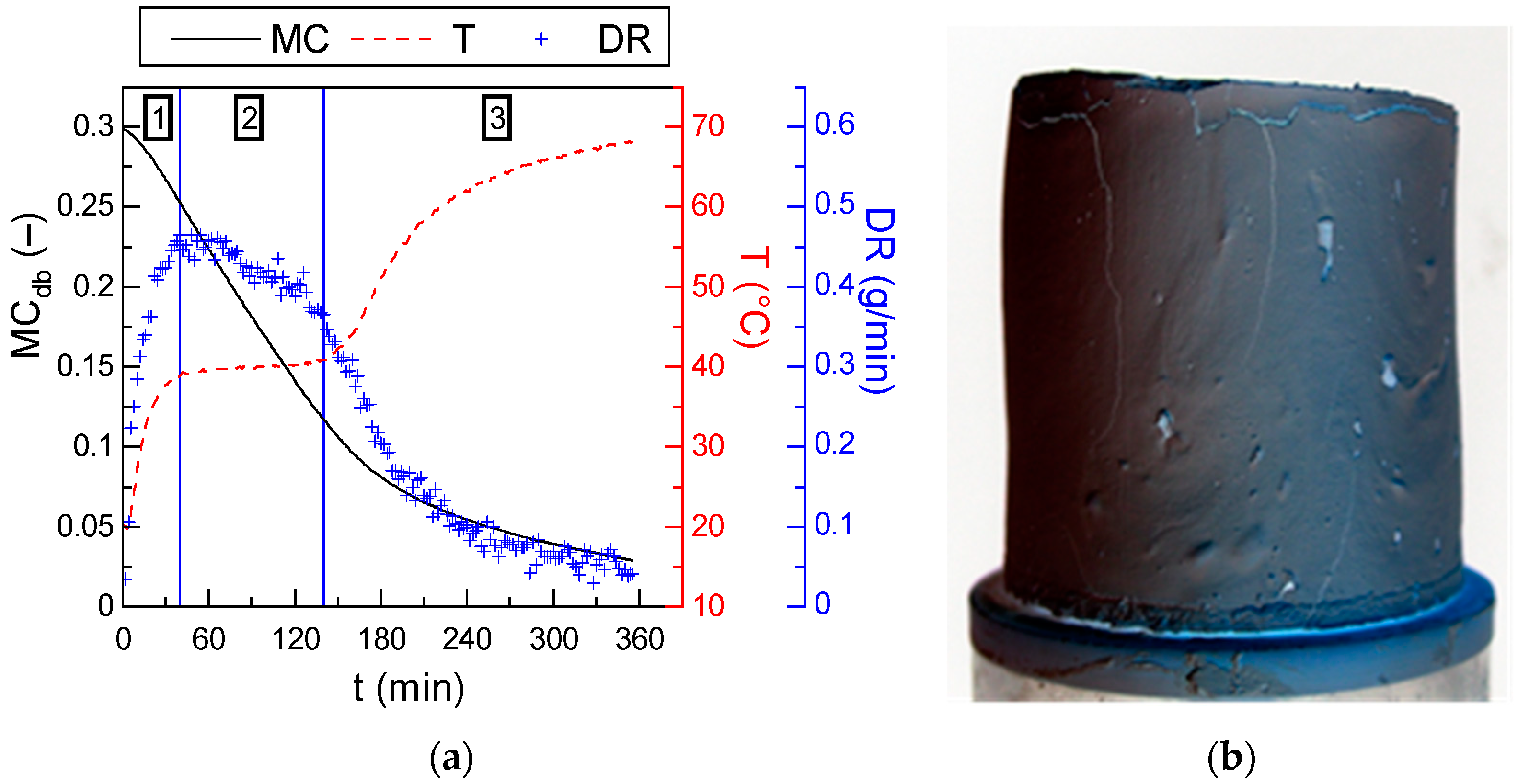

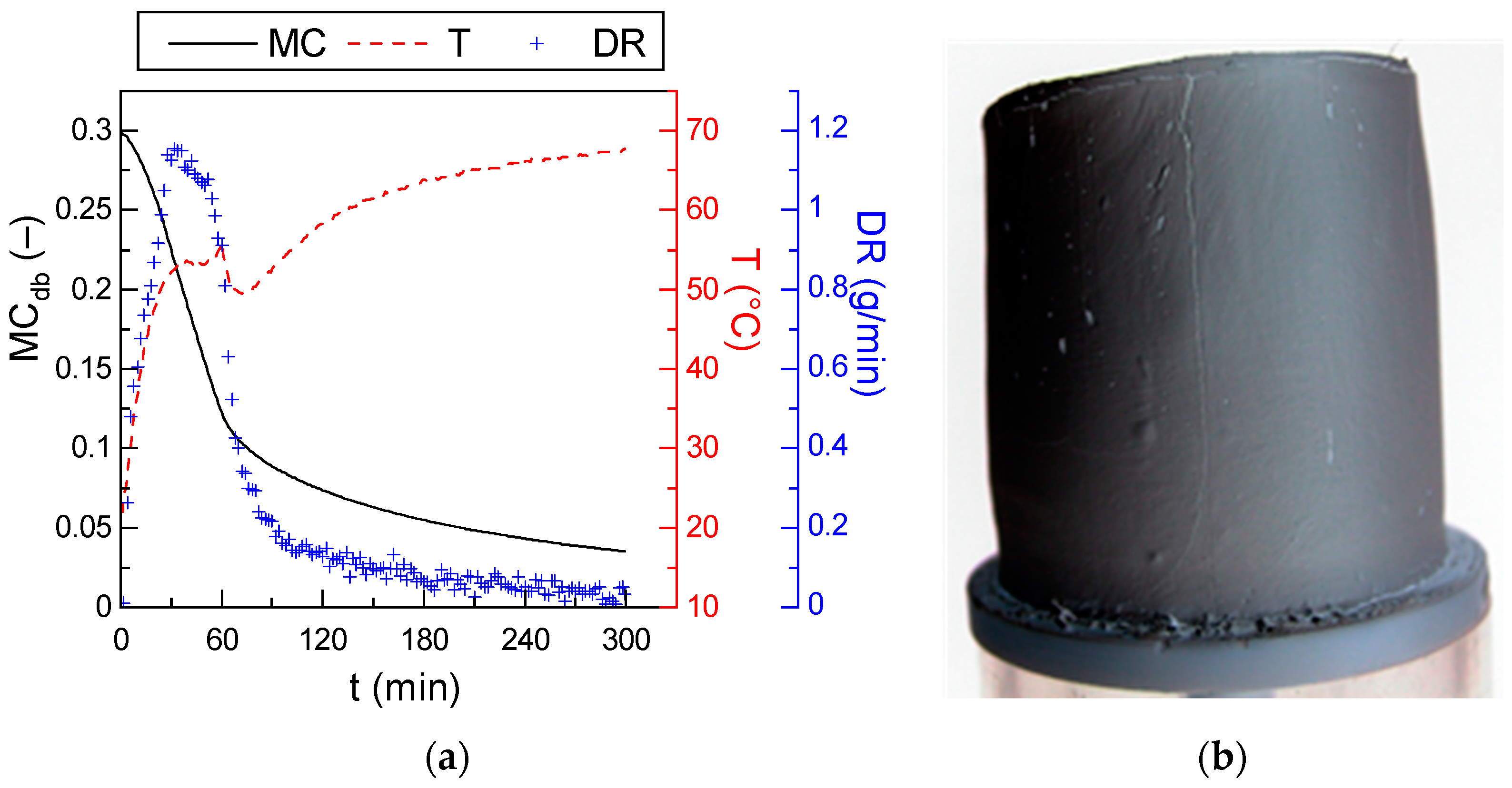

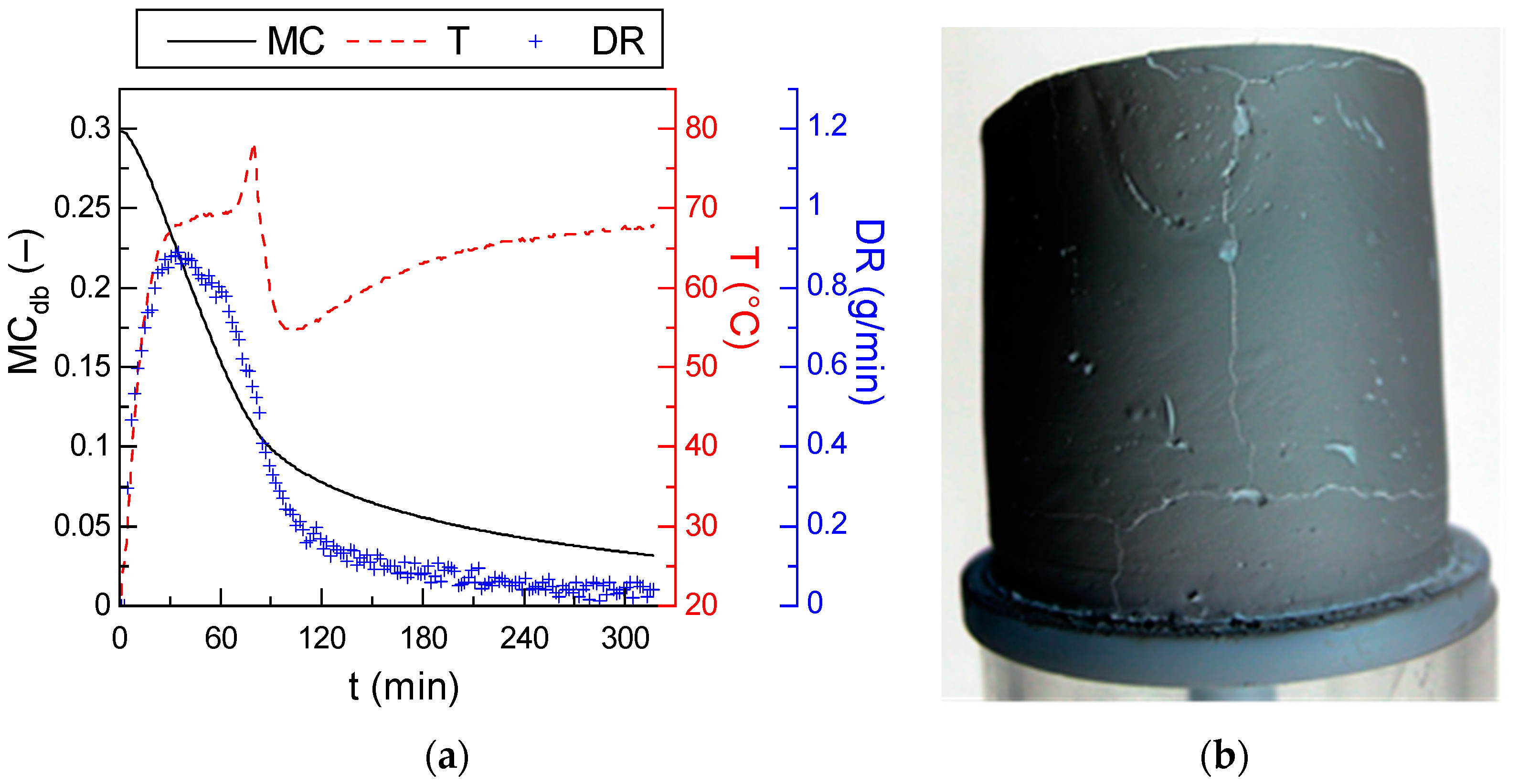

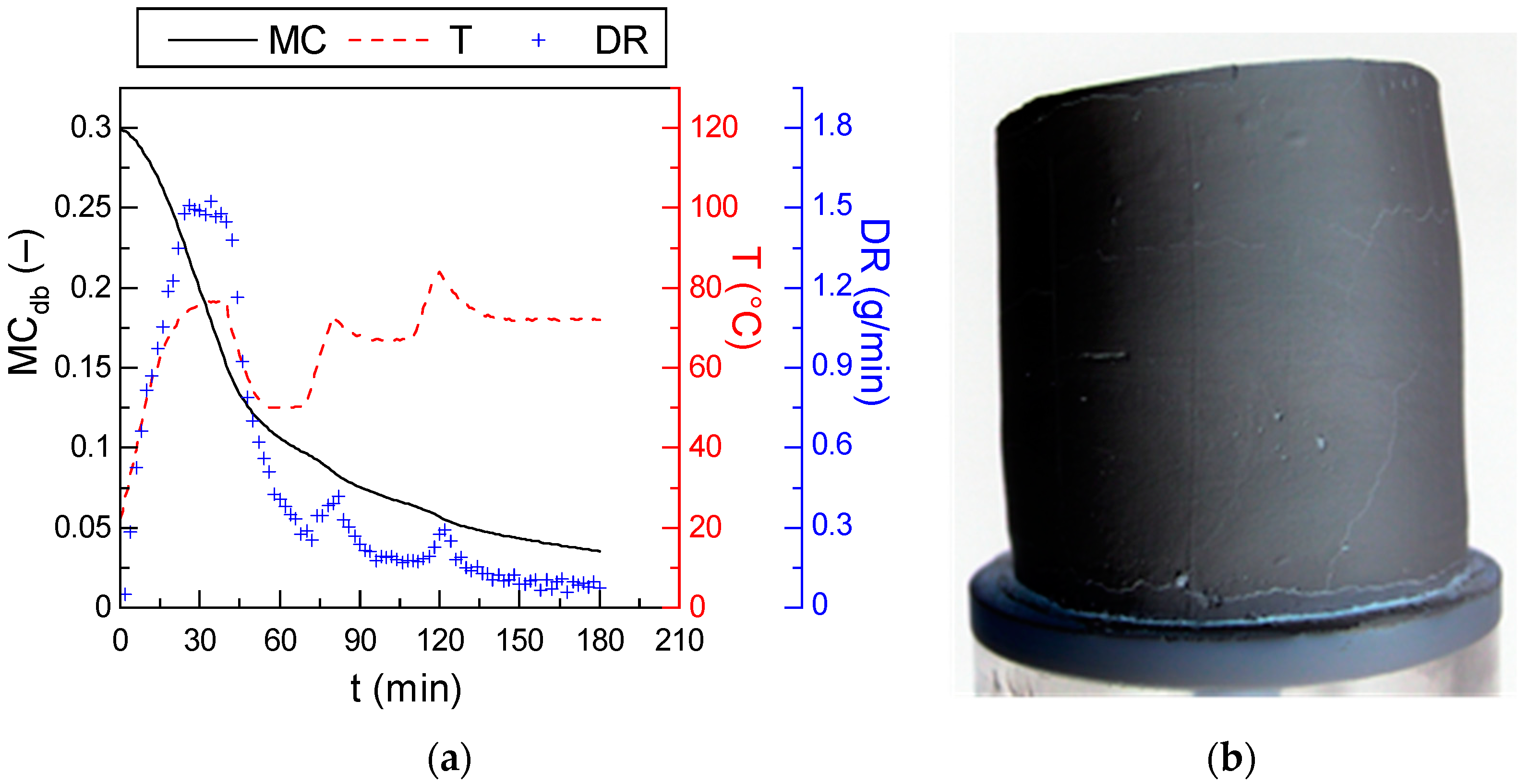
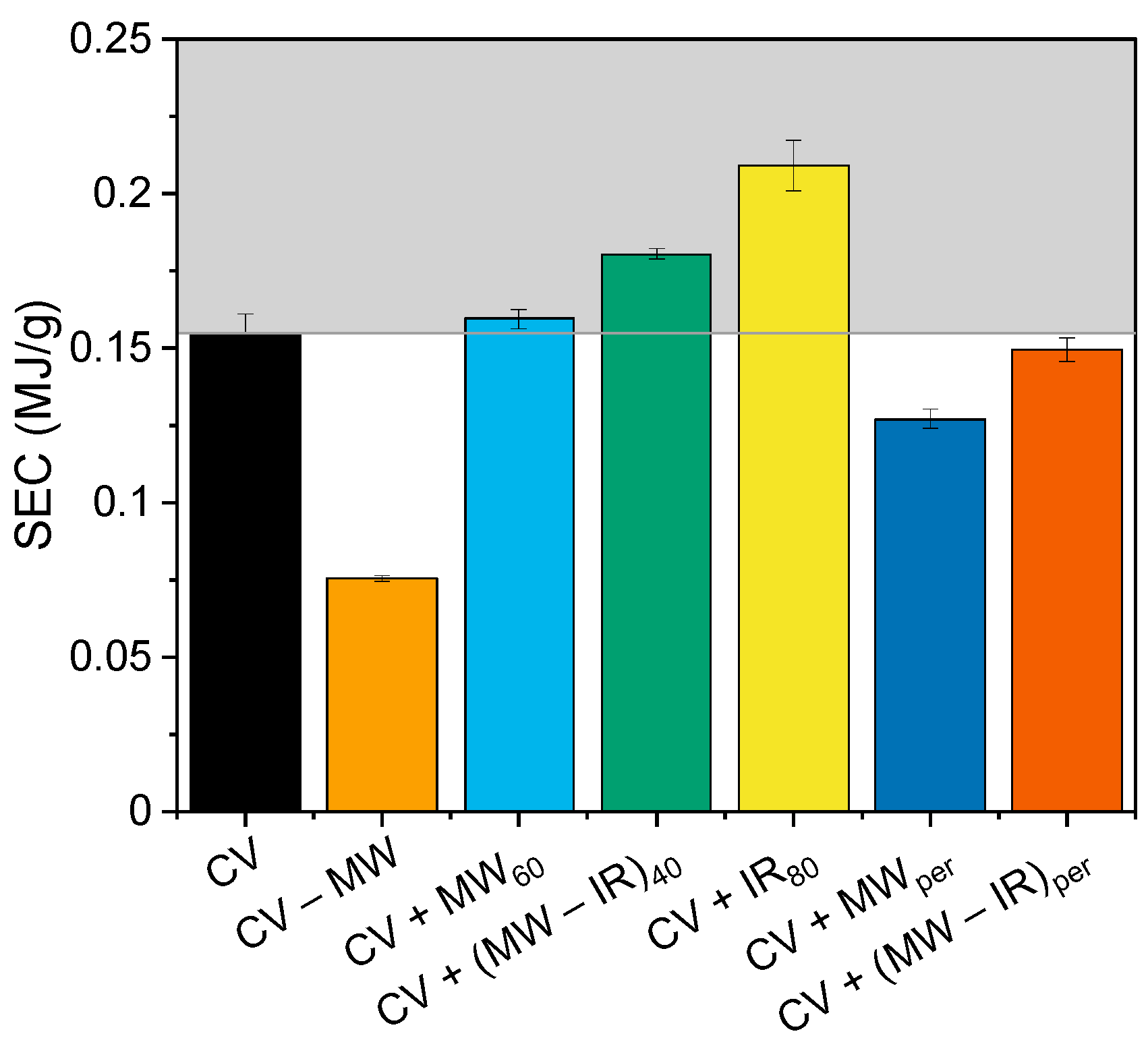
| Component | SiO2 | TiO2 | Al2O3 | Fe2O3 | MgO | CaO | Na2O | K2O | P2O5 | SO3 | Sum |
|---|---|---|---|---|---|---|---|---|---|---|---|
| % mass | 53.3 | 0.5 | 42.5 | 0.4 | 0.1 | 0.1 | 2.0 | 0.6 | 0.2 | 0.1 | 99.8 |
| Schedule No. | Name | Description |
|---|---|---|
| 1 | CV | Convective drying. |
| 2 | CV − MW | Convective drying enhanced with microwave during the whole process. |
| 3 | CV + MW60 | Convective drying enhanced with microwave in the first 60 min of the process. |
| 4 | CV + (MW − IR)40 | Convective drying enhanced with microwave and IR in the first 40 min of the process. |
| 5 | CV + IR80 | Convective drying enhanced with IR in the first 80 min of the process. |
| 6 | CV + MWper | Convective drying enhanced with microwave periodically. The application of radiation was controlled by the time in the following scheme: phase 1: CV + MW → 60 min phase 2: CV → 30 min phase 3: CV + MW → 10 min phase 4: CV → 30 min phase 5: CV + MW → 10 min phase 6: CV → 60 min |
| 7 | CV + (MW − IR)per | Convective drying enhanced with microwave and IR periodically. The application of radiation was controlled by the time in the following scheme: phase 1: CV + MW + IR → 40 min phase 2: CV → 30 min phase 3: CV + MW + IR → 10 min phase 4: CV → 30 min phase 5: CV + MW + IR → 10 min phase 6: CV → 60 min |
| Process | k (s−1) | Standard Error | Adjusted R2 |
|---|---|---|---|
| CV | 0.008 | 9.23 · 105 | 0.9610 |
| CV + MW | 0.017 | 4.95 · 104 | 0.9147 |
| CV + MW60 | 0.016 | 1.62 · 104 | 0.9768 |
| CV + (MW − IR)40 | 0.018 | 1.82 · 104 | 0.9762 |
| CV + IR80 | 0.014 | 1.11 · 104 | 0.9842 |
| CV + MWper | 0.017 | 2.61 · 104 | 0.9669 |
| CV + (MW − IR)per | 0.02 | 2.75 · 104 | 0.9735 |
Disclaimer/Publisher’s Note: The statements, opinions and data contained in all publications are solely those of the individual author(s) and contributor(s) and not of MDPI and/or the editor(s). MDPI and/or the editor(s) disclaim responsibility for any injury to people or property resulting from any ideas, methods, instructions or products referred to in the content. |
© 2023 by the authors. Licensee MDPI, Basel, Switzerland. This article is an open access article distributed under the terms and conditions of the Creative Commons Attribution (CC BY) license (https://creativecommons.org/licenses/by/4.0/).
Share and Cite
Mierzwa, D.; Musielak, G. Convective–Microwave–IR Hybrid Drying of Kaolin Clay—Kinetics of Process. Appl. Sci. 2023, 13, 7451. https://doi.org/10.3390/app13137451
Mierzwa D, Musielak G. Convective–Microwave–IR Hybrid Drying of Kaolin Clay—Kinetics of Process. Applied Sciences. 2023; 13(13):7451. https://doi.org/10.3390/app13137451
Chicago/Turabian StyleMierzwa, Dominik, and Grzegorz Musielak. 2023. "Convective–Microwave–IR Hybrid Drying of Kaolin Clay—Kinetics of Process" Applied Sciences 13, no. 13: 7451. https://doi.org/10.3390/app13137451
APA StyleMierzwa, D., & Musielak, G. (2023). Convective–Microwave–IR Hybrid Drying of Kaolin Clay—Kinetics of Process. Applied Sciences, 13(13), 7451. https://doi.org/10.3390/app13137451






